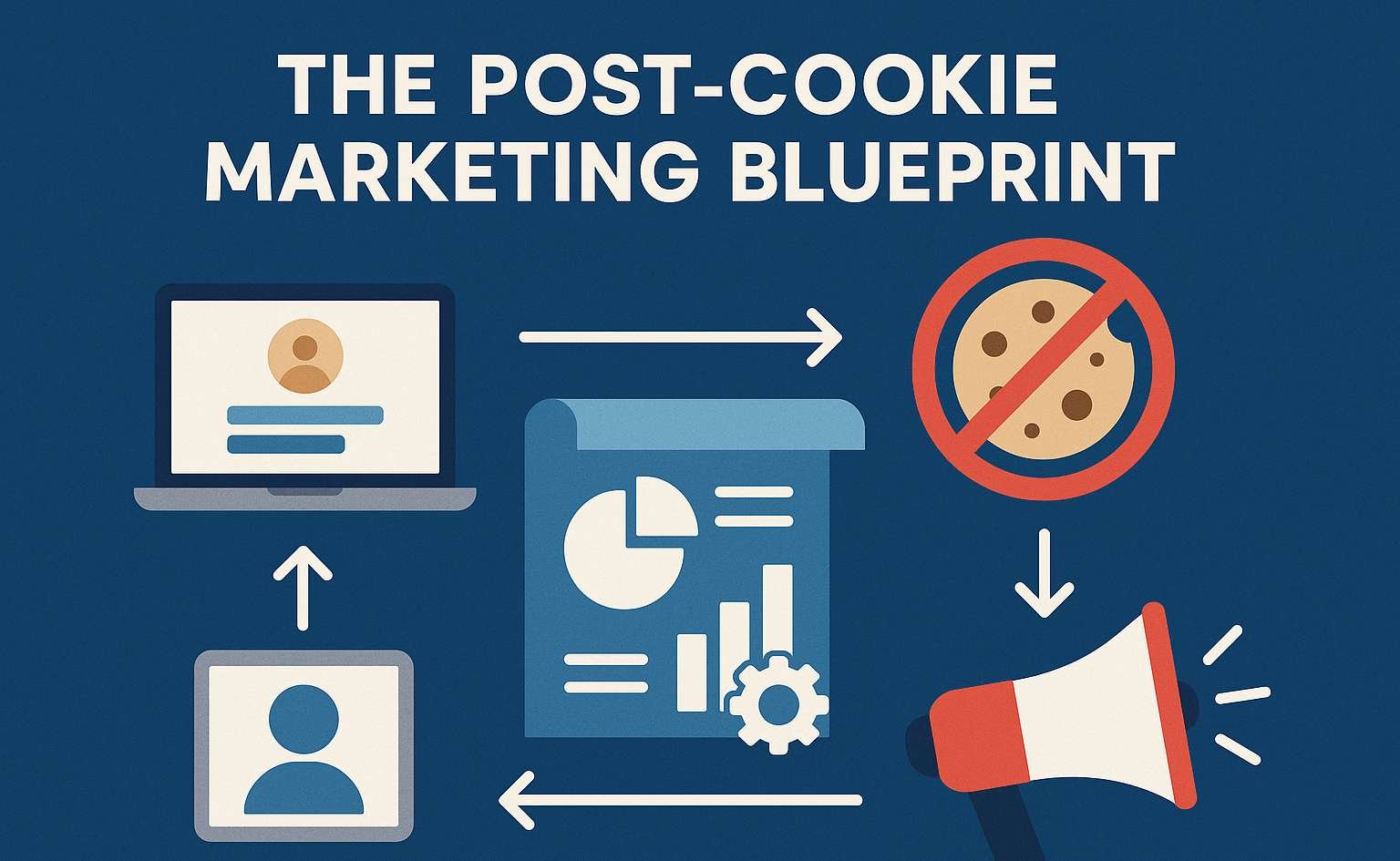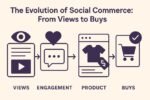Context and Foundations
A cookie-free era has arrived, and marketers must adapt to survive. The influence of third-party cookies is fading, shifting consumer expectations beyond consent to data quality, security, and transparent value exchange. These pressures force a reevaluation of marketing strategies: only the data and signals marketers own can be used without restriction, making the quality and breadth of first-party data and the channels built on it critical to success. Determined marketing leaders are pondering the capabilities required in this cookie-free landscape—what first-party data they need, the appropriate consent management approach, how to measure marketing effectiveness, and much more. The marketers who connect all these dots will create a winning playbook that drives business growth in a cookie-free world.
As the name implies, this cookie-free marketing playbook covers every aspect of modern marketing in a cookie-free world. It operates within three essential boundaries: a first-party-data-rich foundation, ethical use of that first-party data, and a privacy-centered mindset aligned with legislation such as the General Data Protection Regulation (GDPR) and the California Consumer Privacy Act (CCPA). Marketers must bolster their data capabilities—retaining ownership of as much data as possible in a quality-controlled way, using it in accordance with consumer consent and preferences, and ensuring that it supports solid measurement and attribution strategies.
Understanding the Cookie-Free Landscape
The marketing landscape continues to iterate toward greater consumer privacy. Product and service launches such as Apple’s Mail Privacy Protection and Google’s Privacy Sandbox are aligning with global regulatory movements. Demand for privacy-forward experiences is high; consumers cite desire for improvement in brand privacy practices as a primary driver of change. Brands that miss the pivot to privacy-transparency will incur reputational and economic harm from consumer backlash and regulation sanctions.
The dichotomy driving change is simple: growing consumer and regulatory demand for privacy is clashing with the ability to track people—not ads—across the web. As the balance shifts toward privacy, brands must abandon reliance on user-level, third-party data and cookies for audience targeting and measurement. Marketers must focus on using brand-owned data and insights to inform first-party execution strategies that drive engagement and conversion, relying on privacy-forward measurement methods to assess impact.
Key Definitions: First-Party Data, Consent, and Privacy by Design
Understandability will be enhanced by the constant use of three important terms in any marketing document. Therefore, their meaning is outlined here in the first place. Consent for using personal data may be reasoned by the ethical principles of Privacy by Design.
First-party data are the digital footprints that customers have left on the company’s property, for instance on its website or in its app. Consent is an indication of the customer’s agreement or disagreement to the processing of their personal data for a specific purpose. Privacy by Design refers to three principles that erect emotional barriers for customers and resist their departure from a website, thus increasing the likelihood for data leakage and giving value to the data orientation that sustains the company’s business model.
Ethical Considerations and Regulatory Grounding (GDPR/CCPA/CPRA)
Global privacy regulations shape many aspects of marketing strategy and implementation. Knowledge of these issues will make it easier to develop high-quality first-party data and to obtain informed consent from users. This enables capabilities that are essential both for effective marketing and for sustained development of consumer trust. In the cookie-free marketing world, privacy regulations are much more than a legal hurdle to be managed; they serve as the necessary underpinning for a privacy-forward company strategy.
Privacy regulations such as GDPR, CCPA, and CPRA impose broad constraints on how organizations collect, retain, and utilize consumer data, making it vital for marketers to recognize these restrictions. Beginning with a general overview of regulations, this section identifies the changes needed to maintain compliance throughout the marketing lifecycle. Together with the prior discussion of consent, these considerations prepare marketers to audit their organization’s data assets and capabilities. In a cookie-free marketing ecosystem where a brand’s audience is built from the ground up by nurturing trust, aligning with user needs through genuine consent becomes a critical first step.
Data Strategy in a First-Party World
A cookie-free landscape mandates a shift to first-party data as the primary source for segmentation, audiences, personalization, measurement, insights, and testing. Brands must establish repeatable, scalable processes for developing, governing, and monetizing first-party data. A strong data strategy for the cookie-less world plans for data capabilities and infrastructures that respect user consent and privacy.
Cookie-less measurement frameworks validate reliance on first-party data. Using first-party assets for targeting and attribution is driven by consented data. Audience development and personalization strategies leverage consented data and contextual signals. Privacy-forward channel strategies encompass all media, ensuring email and messaging efforts honor opt-in requirements. Companies build consent management systems and preference centers to direct customers toward providing the right data at the right time. An audit of existing assets identifies levels of consent across first-party data; the data hygiene plan remediates health issues. All marketing functions align with an organization-wide commitment to user privacy. Relevant experiences are designed with care to avoid data leaks and security vulnerabilities.
Auditing Your Data Assets and Gaps
Assessing the data landscape lays crucial groundwork for success in a cookie-free world. The goal is a thoughtful reconciliation of risk and reward, rallying behind first-party assets while diligently identifying and addressing gaps and areas of concern. Additionally, clearly delineated inventories of data authorities, sources, and missions foster knowledge sharing and operating efficiencies.
Start by inventories that encompass every kind of data asset within your organization, including first party, second party, and third party. Then evaluate those assets through three lenses: (1) Are they crucial for executing your marketing strategy? (2) Are they delivering the quality needed to achieve your marketing mission? (3) Are you comfortable with the privacy choices associated with those assets? These lenses form the bedrock of a data hygiene strategy that fuels successful real-time activation, precise audience segmentation, targeted lifecycle journeys, compliance-forward measurement, and governance across the organization, enabling a healthy balance between risk mitigation and reward maximization.
Building a Robust Data Hygiene and Quality Plan
As data-driven marketers, we know that bad data costs us real money. Yet that knowledge via PowerPoint presentation and fully justified expense is one thing; scaling effective data hygiene is another entirely.
Here’s how to tackle the data hygiene and quality challenge:
**Outline the processes and automations needed to cleanse, deduplicate, and standardize data.** Data cleansing removes inaccurate, incomplete, or malformed data by checking for typos, conventional spellings, and standard formats. Duplicated records for the same user can lead to confusion in marketing messages and wasted credits for third-party databases. Ensuring standard formats for addresses, phone numbers, ZIP codes, and area codes supports better data hygiene on a broader scale and makes advanced analytics easier. From simple rules through complex machine learning models, data-cleansing capabilities generally require a balance of rigid business rules for the simplest data cleaned and gentler human-judgment-enabled ones for more complex data.
**Use consent management and preference centers to ensure data use respects the consent provided.** Monitoring permission, updates to preferences, and deactivation requests safeguards the respect-first approach essential to building an omnichannel marketing practice that maintains trust. Collection prompts drive participants to consent to virtually all channels in exchange for relevant experiences, yet even those without such a prompted license need processes and experience monitoring to remain trustworthy.
Consent Management and Preference Centers
Consent, preference, and privacy management follow a lifecycle that begins with a user entering a cookie-free environment controlled by the marketer. UI/UX design determines whether to request the user’s identity and associated consent as traffic enters an owned asset used for cookie-free marketing. These signals must be captured consistently across these entry points to create a cohesive view of consent and preference within the consent management platform, customer data platform, and analytics environment. Consent management should fully support hidden consent through pre-consent noise capture and supported and managed consent through permissioned channels suitable to the communication. Groups should be user-centrically organized and easily understood to maximize adoption, helping make lifecycle marketing at scale and the personalization of creative content and experiences safe and respected activities.
Ultimately, traffic that receives lifecycle marketing and privacy-sensitive treatment should have access to a suitable privacy policy that transparently and very clearly details how the data may be utilized. The privacy policy should reconcile the subject of the cookie-free marketing, which will ultimately be the advertising. It is likely that these users will have little incoming traffic from other channels, such as paid media, so have no expectations of marketing-based ads. As shown in the Cookie-Free Channel Strategy and Tactics section, the bulk of the budget should be focused on building the community and paid media channels based on user consent.
Measurement and Attribution Without Third-Party Cookies
While third-party cookies will soon be a thing of the past, it is still possible for marketers to measure media effectiveness and understand consumer behavior within a cookie-free world. The justification is primarily twofold: First, marketers are seeking to align measurement approaches with the same timeline for the transition out of third-party cookies and their overall move toward first-party data frameworks. Second, these measurement and attribution approaches offer a path for marketers to derive solutions even in the absence of a universal tracking mechanism. By prioritizing solutions that minimize reliance on third-party cookies, marketers will be better positioned to adapt measurement and attribution methodologies as the cookie window closes.
Privacy safeguards must be prioritized, leveraging a combination of experimental designs, incrementality testing, and first-party data–centric attribution models. These steps enable media owners and brands to isolate the effect of media placements and other marketing tactics. Along the way, marketers must prepare holistic measurement frameworks that present media effectiveness along common metrics and journeys, while also ensuring metrics tell a clear story to executives and cross-industry stakeholders. Once clearly defined, these high-level measurement dashboards inform the creation and selection of the underlying incremental testing methodology and subsequent model selection.
Incrementality Testing and Causal Inference
Incrementality testing and causal inference remain important components of a cookie-free measurement strategy, especially for validating investment decisions and large campaigns. Business and marketing leaders need to know which inputs contributed to the outputs, and a blind trust in correlation-based models is dangerous.
An incrementality-testing culture emphasizes experimentation. Marketing teams, in partnership with product and tech, should proactively design experiments for major initiatives with clear hypotheses and guidelines for success. The execution, results, and next steps should be documented and accessible to relevant stakeholders. In addition to dedicated experiments, optimized funnels should be used to compare organic and paid traffic in a causally interpretable way. All results, especially those from dedicated experiments, should feed directly into a library of best practices and any existing attribution or modeling framework.
Unified Measurement Frameworks and KPIs
Overarching dashboards for marketing performance must account for the constraints imposed by the cookie-free paradigm and regulatory laws, including user privacy and data quality. A Unified Measurement Framework serves as the guiding light for all marketing activities across channels and audiences. Cohesive metrics provide an essential lens for steering and unifying teams, allowing them to explore the questions “What is working?” and “How can we make this work better?”. Complementary Attribution Models About Privacy-Preserving Techniques delineate how marketing effectiveness is assessed—essentially, “How do we know it worked?”.
Effective advertising acts like a magnet on a target audience regardless of device, signal, format, or placement, driving messages to where clusters of demand naturally assemble without the advertiser chasing every individual’s attention. The Unified Measurement Framework is your marketing organization’s invisible magnet, revealing where consumers are congregating so your advertising can appropriately push through market noise. Using the magnet analogy, all marketing traffic sends out beacons into the digital marketplace—in many forms—and that digital market responds back, revealing segments of demand within the greater target audience. The Unified Measurement Framework then shows not just if the magnets did their jobs, but what roles they played across a digital market of beacons that responds and creates demand.
Attribution Models Compatible with Privacy-Preserving Techniques
Attribution Models Compatible with Privacy-Preserving Techniques: Privacy-preserving bidding strategies, probabilistic targeting, contextual scoring, and creative consolidation enable privacy-forward sales modeling.
Attribution approaches should accommodate privacy-first audience targeting as well as cookie-, device-, and identity-less bidding. Fully embracing these decoupled opportunities requires a shift in the creative strategy by aligning the competitive messaging of all paid media channels. Consolidation into portfolio offers can further reduce the exposure of the brand’s distinct creative expressions. While an incremental testing approach remains ideal for quantifying the sales impact of these portfolio offers across various activation channels, the attribution modeling methods discussed here can provide some directional guidance according to the sales impact estimates from more targeted activity.
Audience and Personalization in a Privacy-First Era
While consented first-party data—coupled with privacy-safe contextual signals—must drive audience selection, privacy safeguarding must be a priority. Marketing teams can foster personalization and relevance by leveraging the rich dataset they own and access during audiences’ or customers’ relationship with the brand, but these personal experiences should not be approached lightly. Profiles shape customers’ and audiences’ perception about the brand and the products offered. It’s crucial to build this connection with their users while respecting their personal and private lives, especially using privacy-respected data such as those collected via consented first-party data.
Marketers tend to develop audiences based on the behavior of previous years, but shifting consumer behavior and the marketplace are real. Today and in the future, brands need to be hyper-relevant to their audience’s needs, revelation (often fleeting) and behaviors during the purchase journey. Instead of focusing just on previous audiences (such as retargeting), marketers need to be contextual. They need to think more about what they talk, when they talk, and where they talk, rather than just being more aggressive on getting the audience with a lower Click to Rate but little value. Create great message, show authenticity, communicate around the brand values, and be contextual should be the approach.
Segmenting with Confidence Using First-Party Data
In a cookie-free world, the segmentation that usually drives ad targeting moves behind the scenes and uses custom audiences, likelihood-to-convert scores, and preferences gained through explicit consent. However, it is still possible to create segments for targeting ads, allocating spend, and triggering personalized journeys that feel relevant to each recipient.
Segmentation using first-party data starts with an audience and influence segmentation approach. Start at the audience level—with custom audiences for ads or CRM targeting—then think in terms of influencing likelihood and context. Custom audiences build on owned data as well as lookalikes or probabilities from other platforms, such as likelihood to convert. Audience Influence Segmentation further influences likelihood scores using other signals, such as propensity to engage or more general contextual fit. If the audience is receptive, lifetime stage scoring helps trigger the most relevant message at each point.
Contextual Targeting and Creative Personalization
Brands must continue to deliver value to consumers while acknowledging their privacy needs. As a result, creative teams should create marketing messages, landing pages, and experiences that are personalized using context and privacy-safe behavioral signals.
Although the internet’s advertising ecosystem is in flux, a key opportunity remains to ensure that every dollar spent brings value to the consumer at the same time. Personalization has proven to drive significantly better results for many brands when applied correctly. Contextual signals like browsing or app usage behavior, weather and time of day, geolocation signals, and audience interactions with media can all help provide fresh, interactive, relevant experiences that consumers enjoy in the privacy-first world. A well-executed targeting and personalization strategy, combined with smart creative concepts that leverage the context of the impression, can help grow the business now and when normality returns.
Lifecycle Marketing and Personalization at Scale
To thrive in a landscape without cookies, marketers can maintain relevance and drive results by applying first-party data, context, and consent signals to Lifecycle Marketing and Personalization efforts. Broadly defined, Lifecycle Marketing depicts strategies for customer acquisition, activation, retention, and reengagement. By respecting the privacy and preferences of customers and prospects, privacy-safe Lifecycle Marketing activities will leverage first-party data for personalized messages with minimal impact on the user journey.
Lifecycle Marketing spans all audiences, from highly personalized nurtures and journeys to privacy-safe creative systems that resonate with anonymous users. Used throughout Acquisition, Activation, Retention, and Reengagement, consented first-party data and contextual signals can create relevant experiences with minimal reliance on enriched segmentation. Acquisition leverages owned channels, trusted communities, and privacy-safe media placements. Activation highlights journeys toward product experience and value triggers. Retention emphasizes delighting and servicing customers and prospects through contextual triggers and reduced user friction. Reengagement embodies gentle nudges toward customers who lose value signals.
Channel Strategy and Tactics
A comprehensive strategy across channels must operate without cookies, linking to each channel’s specific activation approach to support execution. Paid media acquisition tactics connect to the creative plan, emphasizing the importance of using contextual signals to reduce risk. Developing a strong owned media strategy enables businesses to build audiences that can be activated via email, SMS, and messaging. It is crucial to prioritize privacy-safe targeting when deploying paid media campaigns.
Subchannels like email marketing, SMS, and messaging should serve as core channels for paid media acquisition efforts. Establishing and nurturing relationships based on permission lays the foundation for more personalized messaging that improves engagement and campaign performance. Visibility into customer journey convergence allows control over cadence. Respective privacy statements define and communicate data use practices. The activation plan for each channel articulates how audiences will be reached while monitoring for fatigue.
Email, SMS, and Messaging as Core Channels
The ongoing and projected decline of third-party cookies means email, SMS, and messaging are among the few remaining channels capable of reaching users at scale while respecting privacy. Slot these channels at the heart of your channel strategy. Adopt a strategy for these channels that grows the foundation of permissioned users throughout the customer lifecycle.
Craft a strategy that governs how you communicate across these channels. Identify cadence, topics, and audience for each channel. Avoid over-communicating to prevent churn. Segment messaging cadence to higher frequency for high-value prospects and lower for those with no recent engagement. Prioritize individuals who have engaged recently for a conversion, retention, or re-engagement message. Integrate the strategy with other areas and channels. For instance, align topics and creatives with overall priorities. Update audience lists with signals from all channels and sources. Last, report performance by channel as well as the business’s overall progression.
Paid Media with Privacy-Respecting Signals
Privacy-forward marketing doesn’t mean scrapping paid media—it merely entails adjusting tactics to lean on signals that respect consumer preferences. Within these boundaries, performance remains essential. The ride might look different, but seasoned marketers still find ways to achieve their goals.
Within privacy finance, bidding, targeting, and attribution all pivot toward privacy-respecting signals. Audience reach may become a challenge depending on the channel and its reliance on cookies or other identifiers. The industry has seen moves toward contextual targeting with an eye on respect. Ad placement might emphasize more awareness and engagement than pure click-through. Nonetheless, marketers nurture the full spectrum of the acquisition funnel and its capabilities, depending on consumer taste and behavior.
CRM-Driven and Community-Focused Growth
Owned media and community-driven channels are the best foundation for sustainable growth without cookies or third-party data. At the same time, building these assets requires effort and investment, and might not yield immediate results. As a business seeks growth, it must balance different approaches:
Using its owned channels—website, email, app—to engage customers actively, especially those in the repeat segment, promote and communicate directly, and with a clear consent management plan.
Leverage community-driven channels—paid media, partners, affiliates, influencers—to build audience quickly and reach without directly controlling the user experience.
Technology Stack and Vendor Governance
Cookie-era marketing infrastructures were built around third-party data and applied in questionable ways. As reliance on third-party cookies ends, the focus shifts toward first-party ecosystems with a permission-based data strategy. Such a data strategy requires technology that puts consent at the center of operations across the marketing function and beyond. Privacy-forward consent management, identity architectures, and data platforms enable execution in this new cookie-free world. Choice and control must always be available to users, and marketing teams must ensure that they respect those choices. Key stakeholders require a common set of rules for what happens to data in each scenario, who has access, the purpose, and the choices available to consumers. When these key stakeholders have aligned on the purpose of the information, have given or denied consent, and have the means to manage their privacy, tools should simply work.
Choosing Data Platforms and CDPs for Privacy
When selecting any data platform or customer data platform (CDP), prioritize privacy and consent readiness among your requirements. Data-driven identity management, including graph-building and reconciliation, must support consent management and storage. Rather than storing user-level ad IDs, identity graphs for measurement or targeting should rely on non-user GDPR-Sensitive data. Platforms that rely heavily on user-level identifiers demand scrutiny. Data fusion projects must treat consent as primary; a signal design should allow users to express granular preferences. A properly architected system won’t require user IDs to be uploaded at scale; uploading logs of Serving IDs, especially for programmatic buy-Selling and Ad Buying Center vendors, is possible—doing so for creative vendors might be feasible and efficient
The privacy readiness of the tech stack is rooted in the selection criteria of all data platforms. Identity management should be privacy-preserving. Ingested signals and output activations must respect consent. Vendors should be audited not just for privacy but for the policies, practices, and controls underlying the operations, especially when they involve large teams, user data, or DSP-like controls.
Consent, Identity, and Data Integration Architectures
The consortium focuses on architectures that define the people, signals, and data barriers required to thrive in the evolving marketing landscape. Marketers must establish consent management systems that explicit deny unwanted engagement, create scalable identity systems that support the detection of consented users, and implement data platforms that fuse information from diverse sources while maintaining privacy.
All architectures must respect consent and identity signals. The governance processes, technology safeguards, and alerting mechanisms defined elsewhere ensure these parameters are enforced. Decisions should also satisfy the principles outlined in the Marketing Principles and Ask First sections. The goal is to build robust consent and identity structures that broaden the future-focused data architecture, enabling marketing teams to detect users, acknowledge consent, and utilize the rich array of data signals—while respecting users’ privacy.
Vendor Management, Audits, and Compliance
Governance and oversight processes must manage the risks associated with third-party technologies, ensuring compliance and safeguarding customer trust. The accelerated rollout of consent requirements and other privacy protection measures requires the marketing function to engage in vendor risk assessments thorny questions such as: “How is the company’s consent and identity information being stored during the data integration process? Where are the data bits travelling through Rank’s vendor tech stack? Are there any AI processes taking place that require additional notice or possible opt-in with customers?” The use of third-party platforms may no longer be viable without the consent of the brand, and this makes it harder to justify why large advertising networks are not treated with the same scrutiny as any other third-party vendor.
Marketing must establish trusted relationships with consent management platforms, identity resolution platforms, customer data platforms, APIs for systems of record, permission-based email and cloud messaging service providers, tag management system vendors, audience segmentation and presentation bias mitigation vendors, culture and relationship management platforms, and others. Alert support teams of vendor audits, contract risk assessments, security incident responses, and compliance, privacy, and security drills to guarantee the company is complying with all consent agreements and sharing data responsibly. Monitoring dashboards should include consent data lineage and consent audit trails, with the inclusion of individuals who interact directly with customers to safeguard sensitive consents from inappropriate data use.
Content, Creatives, and Experience
Creative strategy must evolve to adapt to privacy-preserving marketing principles. Relevant, effective personalization still exists without cookies, but it has become more challenging. Permission-based engagement now remains a two-way street, so the user experience must actively provide users with compelling reasons to engage and share their data. Understanding what motivates audiences remains a skill every marketer must master so that messaging resonates and compels action.
CREATIVE STRATEGY COMPONENTS THAT DRIVE SUCCESS WITHOUT COOKIES Effective creative strategies require a clear articulation of context, value, and consent signals that guide concept development and execution of assets across formats. Strategies should center on three foundational elements: • Contextual signals create the framework for messaging. Media placed together lets consumers define expectations; for example, a message about luxury travel has an entirely different perception on a travel blog versus a meme-centric creative site. • Value exchange motivates engagement. The incentive can be functional (a discount or exclusive offer) or emotional (entertaining, informative content). • Consent increases relevance and warmth. Data shared through a preference center or engaged through UX signals allow for customized experiences. These principles help ensure that the creative resonates with the audience and context, increasing the likelihood of user interactions in channels with stricter privacy management than before.
Creative Strategies that Thrive Without Cookies
Creative concepts must leverage context, value exchange, and consented data to drive compelling performance while respecting new restrictions. The danger lies primarily in user apathy toward non-transgressing advertising rather than outright rejection.
Currently, audiences tune out all ads, whether or not they have personalization. User researches continue to show consumers dislike irrelevant advertising, so ads can do best by using signals relevant to the setting. Signals not directly related to the brand or its offering remain essential, akin to how movie trailers create excitement for a coming attraction. However, cookie-based retargeting ads that have nothing in common with search ads, or that look like an older, awful version of the product itself, only resemble what people want from advertising. Advertising is audience interaction with brands, so that is the goal ad creatives should work for, whether the ad impulse comes from an SOS moment or simply boredom.
Optimizing Landing Pages and Conversion Flows
Conversion-focused landing pages and flows are critical to achieving optimal performance in a privacy-first era. A cookie-free world is defined by heightened consumer privacy expectations. In an age of heightened consumer privacy expectations, enhancing conversion-focused landing pages and flows is essential to achieving optimal performance. Marketers must accommodate these heightened expectations by moving consumers through a clear and compelling privacy-safe value exchange. Improvements will center around UX design principles as well as speed and clarity, ensuring an engaging consumer experience that entices further interaction.
Speed is critical at every stage of the buying process. Privacy risks remain especially prominent within landing pages; careless implementation can easily expose either user identity or lead scoring risk. Marketers must therefore establish strong connections with their creative and content teams, highlighting UX, speed, and clarity imperatives relevant to their whims. User experience should be a strong focus throughout design and testing, ensuring not only that the user journey is intuitive and frictionless, but also that it can be clearly demonstrated through field data.
Privacy-Safe Personalization in Creative Content
Marketers have long relied on vast troves of third-party data and intrusive tactics to deliver ads that often border on creepy. In a cookie-free world, advertising must evolve for the better: The result is relevancy at scale, made possible by combining the principles of privacy, contextual targeting, and creative personalization.
In a world where third-party data is vanishing, personalization is now rooted in data, signals, and contexts that are consented or generally acceptable for privacy reasons. Privacy-safe personalization rests on five basic principles: Content, including ads, must either provide real value or be so contextualized that users feel comfortable seeing them. Segmentation must be fundamentally different from previous practices, data-driven but adopting strict guidelines on the application of sensitive data. Targeting via data must rely on first-party data collected through user interactions and consent, contextual signals, and carefully chosen privacy-safe data signals from data providers with a solid privacy commitment. Creative personalization must leverage context in ad copy, visual elements, and offers.
Measurement, Reporting, and Governance
Measurement and governance for a cookie-free marketing world require careful alignment of analytics, controls, and behavioral incentives.
Privacy-forward dashboards provide a consolidated view of success, controls monitor risk management and regulatory compliance, and an experimentation culture ensures continuous improvement. Together they provide the necessary feedback to support sustained business and marketing success.
Privacy-Forward Dashboards and Analytics
In the cookie-free marketing ecosystem outlined earlier, the principles of privacy by design and privacy by default must govern not just the underlying systems and operations but also the marketing and analytics processes that assess brand success and marketing performance. Marketers need to assess performance privately and share results appropriately across the business. This section outlines the marketing metrics, monitoring dashboards, and associated access privileges that comply with these privacy-forward principles.
Organizations embarking on cookie-free marketing journeys must identify specific datatypes that require privacy-preserving practices. Each datatype must have its privacy-impacting metrics governed through access controls and monitoring. Custodians of metrics sensitive to personal identification should be responsible for implementing appropriate measures. Such measures include defining acceptable use, lines of business, and departments to ensure the analysis does not lead to monitoring individuals. Examples of such metrics are conversion rates, email/sms open and click rates, virality scores, unsubscription maps, trend patterns, personal data, first-party audience profiles, and all types of conversion events.
Experimentation Culture and Documentation
A successful cookie-less strategy requires a shift in mindset to experimentation and optimization based on actual results. Start with a clearly articulated hypothesis answering a specific question for a defined audience or business outcome. Natural experimentation may occur if multiple parallel variations run across geographies or audiences due to technical limitations; these should be articulated and treated rigorously to extract real insights. When teams assess results together—whether they succeeded or not—shared learning accelerates growth. Over time, a repository documenting all tests, results, and lessons becomes a powerful asset.
Marketing suffers from abundant poorly defined interventions that cause little impact. As demand acquisition costs rise, tags multiply for attribution but may introduce more noise than signal, yet few resources are devoted to testing to decipher how to shift spend from the least effective to the most impactful activities. Until CDPs enable a privacy-first approach to attribution modeling, firms should apply basic tests to identify signals of effectiveness from all the privacy-preserving methodologies and models that attempt to replace third-party cookies for directional guidance.
Compliance and Risk Management for Marketing
Marketing compliance and risk management begin with a clear understanding of the regulations that govern personal data use within a marketing context. Given the sensitivity and business impact of these data sources, specific controls should be adopted to mitigate the risks of abuse or exposure. The organization also requires a mechanism to handle incidents where data privacy may have been violated or compromised.
Table 8.3 provides a mapping of marketing activities to the privacy controls that govern them. Completing the requirements entails analyzing each identified marketing activity within the context of the regulations defined in the Ethical Considerations and Regulatory Grounding section, considering the party responsible for delivering compliance. User trust in permission-based channels may warrant excess control at the risk of overburdening user experience. Any high-risk activities, such as extensive data enrichment or sensitive personalization, should also receive additional scrutiny on the privacy processes undertaken.
Organizational Readiness and Change Management
The transition to first-party marketing requires discipline, foresight, and collective skills. Preparing for the cookie-free landscape means anticipating a shift from data-optimized operations to a consistent marketing capability — capable, consistent, and cohesive. Anticipating roles and ownership, ensuring teams acquire new skills, and facilitating functional alignment enable operational continuity through a change that has been three years in the making. It’s time to act.
Building a privacy-friendly organization goes beyond marketing. Cross-functional alignment enables product and technology teams to augment marketing capabilities, and deployment across the entire organization frees insights through data literacy and a shared vocabulary. Seamless UX inspires users to willingly share valuable information, and consistent procedures mitigate privacy and compliance risks. Marketing becomes non-linear and demand-driven, facilitating authentic interactions at all stages of the customer lifecycle.
Skills, Roles, and Team Structures
SHARED RESPONSIBILITY CONTROLS: Advanced targeting, measurement, and (sometimes) audience and creative customization can happen only with explicit consent from the customer. It is mission-critical that all marketing activities account for consent at every step.
DATA LITERACY AND CROSS-FUNCTIONAL ALIGNMENT Data Strategy in a First-Party World outlines the relevance of privacy for data strategy. Alignment across Marketing, Product, and IT is vital for building, maintaining, and using the marketing data assets. Joint training creates a shared language and enables Marketing to make product decisions that reduce churn, alert IT to the technical choices that help ensure privacy-compliant data, and engage in meaningful dialogues around data, data access, and data hygiene. Governance rituals help maintain alignment.
Data Literacy and Cross-Functional Alignment
Data Literacy and Cross-Functional Alignment
Taking on the cookie-free future requires efforts beyond just the marketing function. Marketing must work with IT to prepare the necessary technology stack, with Product (and other departments) to shape the product strategy, with Legal and Compliance to ensure all marketing activities respect privacy regulations and safeguards, and with Analytics to establish privacy-forward measurement capabilities. Without collaboration, the cookie-free strategy is bound to fail.
Supporting these cross-functional efforts are initiatives to build data literacy and a common privacy-forward language across all relevant functions. Everyone involved must understand how privacy conditions the available data, and a shared vocabulary helps avoid misunderstandings about privacy trade-offs or the feasibility of various analyses.
Conclusion
Seizing the cookie-free opportunity demands more than tactical repairs; it requires a shift of mindset, culture, and operating model. For such a transformation, coherent strategy and disciplined execution are essential. The detailed instructions outlined in this guide map the path to thriving amid heightened scrutiny of data practices.
Strategic insight governs capacity-building and prioritization. The cookie-free era is already here; marketers must heed its implications, with consumers demanding authentic value exchanges and responsible civic behavior. Partnering with customers to create relevant experiences ensures a marketer’s rightful place in their lives, thus sustaining competitive advantage and business success.












